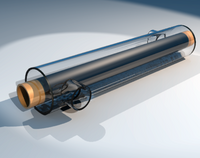
Photo from wikipedia
Abstract Temperature distribution is a vital factor in cutting process for its significant effects on tool wear and tool life as well as the optimization of cutting parameters. With the… Click to show full abstract
Abstract Temperature distribution is a vital factor in cutting process for its significant effects on tool wear and tool life as well as the optimization of cutting parameters. With the gradually wide application of round insert in high-efficiency machining, the precise prediction of cutting temperature distribution for this kind of insert becomes critical. However, the irregular contact geometry between round insert and the workpiece leads to great challenges in thermal modeling. This study focuses on the thermal mechanism of dry turning operation with round insert based on analytical method. A three-dimensional temperature prediction model is proposed based on semi-infinite boundary theory and non-uniform heat partition model. Firstly, a novel discretization approach is utilized to determine the spatial distributions of shear and frictional heat source in a unified three-dimensional coordinate system. Secondly, a new method is developed to determine the intensity of frictional heat source in the presence of sticking-sliding zone at the tool-chip interface. Thirdly, a modified heat partition model is proposed to determine the non-uniformly distributed heat partition fractions on both sides of the tool-chip interface. The predicted temperature isotherms on tool rake face indicate that the area with maximum interface temperature is at a certain distance from the cutting edge. Finally, the proposed model is verified from three aspects including finite-element (FE) simulations using AdvanEdge, comparisons with recent literatures and experiments. Satisfactory agreement between the predictions and the measurements as well as the simulations has been reached. The overall results validate the effectiveness and reasonableness of the proposed model.
Journal Title: International Journal of Mechanical Sciences
Year Published: 2019
Link to full text (if available)
Share on Social Media: Sign Up to like & get
recommendations!